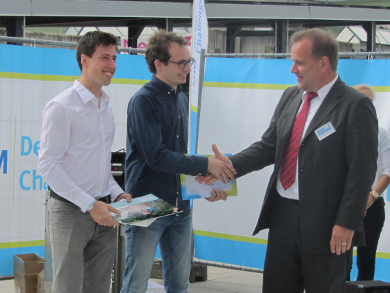The finals of the TUM DeSal Challenge 2016 took place on June 17 and 18, 2016, in Munich, Germany. The competition at the Technical University Munich (TUM) had invited students to build seawater desalination plants powered solely by renewable energy. Clean drinking water is in short supply in many parts of the world, and the ideas of the young participants could be one step on the way to self-sufficient desalination plants for developing countries.
The jury had nominated 12 finalist teams of participants to present their working desalination devices. The plants were judged on the quality and quantity of produced fresh water, but also on design, cost efficiency, ease of use, and innovation. This year’s competition was very international, with participants from Chile, Croatia, Finland, Germany, Iran, Mexico, Poland, and the U.S.
The Winning Teams
The three top ranked teams of the TUM DeSal Challenge 2016:
- The first prize went to Team Helios (pictured above) from Munich, Germany, for their desalination plant, which uses solar evaporation with a parabolic collector.
- Team Alavi from Sari, Iran, took the second place with their system, in which ultrasound is used to evaporate water.
- Team Agribox, also from Munich, won the third prize for their desalination plant, which is integrated into a greenhouse and solves two problems at once: obtaining potable water and growing crops.
Team SolarPura, who we at ChemistryViews interviewed before the competition, came in fourth with their humidification-dehumidification plant that integrates existing structures of typical houses in emerging countries.
Special prizes were awarded for social relevance, innovation, and market relevance, which all went to teams based in Munich:
- Team Cheap Water won the Social Relevance Prize for their plant, which uses PET bottles to cheaply and easily disinfect and desalinate water.
- Team vAquIon was awarded the Innovation Prize for their system that uses high voltage to compress steam.
- Team Agribox received the Prize for Market Relevance for their greenhouse desalination plant. The prize includes two days of training by a business expert to help the team get their approach to the market.
Videos of the Finalists
.jpg) |
 |
 |
 |
 |
 |
 |
 |
 |
 |
 |
 |
Also of Interest
- TUM DeSal Challenge 2016 – Progress Update,
Catharina Goedecke, Felipe Díaz Bórquez, Peter Brailovsky Signoret, Ismael Leitmannstetter, Kevin Lemmer,
ChemViews Mag. 2016.
DOI: 10.1002/chemv.201600044
Preparing for the finals of TUM’s student competition on seawater desalination - TUM DeSal Challenge 2016 – First Experiences,
Catharina Goedecke, Felipe Díaz Bórquez, Peter Brailovsky Signoret, Ismael Leitmannstetter, Kevin Lemmer,
ChemViews Mag. 2016.
DOI: 10.1002/chemv.201600036
Student competition on seawater desalination - All videos introducing the competitors in the TUM DeSal Challenge
- Competition to Design Energy Self-sufficient Desalination Plants,
Vera Koester,
ChemViews Mag. 2013.
DOI: 10.1002/chemv.201300095
19 years old winner of the TUM DeSal Challenge talks about the challenges of developing and building his very successful desalination plant - Building Desalination Plants with DeSal Organizer A. Kroiß,
Sarah Millar,
ChemViews Mag. 2011.
DOI: 10.1002/chemv.201000115
Alex Kroiß, organizer of the DeSal Challenge, Munich, Germany, discusses the event and what inspired him to get involved - Desalination in the Rain: The 2011 TUM DeSal Challenge,
Sarah Millar,
ChemViews Mag. 2011.
DOI: 10.1002/chemv.201000116
The DeSal Challenge at the Technical University Munich provided new ideas for desalination and much fresh water despite the rain




